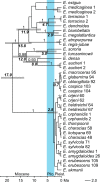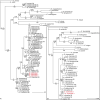Phylogenetic data reveal a surprising origin of Euphorbia orphanidis (Euphorbiaceae) and environmental modeling suggests that microtopology limits its distribution to small patches in Mt. Parnassus (Greece)
- PMID: 36875595
- PMCID: PMC9978759
- DOI: 10.3389/fpls.2023.1116496
Phylogenetic data reveal a surprising origin of Euphorbia orphanidis (Euphorbiaceae) and environmental modeling suggests that microtopology limits its distribution to small patches in Mt. Parnassus (Greece)
Abstract
The Mediterranean Basin is one of the most biodiverse areas in the world, harboring 25,000 plant species, of which 60% are endemic. Some of them have narrow distributions, such as Euphorbia orphanidis, which is only known from alpine screes on Mt. Parnassos in Greece. Its exact distribution in this mountain was, however, poorly known, and its phylogenetic origin was also unclear. We performed extensive field work in Mt. Parnassos and could register E. orphanidis only in five patches of limestone screes in the eastern part of this mountain range, emphasizing its very narrow distribution, which is likely limited by topography influencing water availability as indicated by environmental modeling. We also registered 31 accompanying species and thus characterized its habitat. Using nuclear ribosomal internal transcribed spacer and plastid ndhF-trnL and trnT-trnF sequences, we show that it belongs to E. sect. Patellares, despite not having connate raylet leaves typical for this section, and not to E. sect. Pithyusa as previously suggested. The relationships among the species of E. sect. Patellares are poorly resolved, suggesting their simultaneous divergence that dated to the late Pliocene, which coincided with the establishment of the Mediterranean climate. The relative genome size of E. orphanidis is in the range of that for the other members of E. sect. Patellares, suggesting that it is diploid. Finally, we performed multivariate morphological analyses to generate a comprehensive description of E. orphanidis. Based on its narrow distribution and the anticipated negative impact of global warming, we consider this species endangered. Our study demonstrates how microrelief can limit the distribution of plants in topographically heterogeneous mountain environments and likely plays an important, yet neglected, role in shaping the distribution patterns of plants in the Mediterranean Basin.
Keywords: Mediterranean basin; endangered species; endemism; environmental modelling; morphometry; phylogeny; taxonomy.
Copyright © 2023 Faltner, Wessely and Frajman.
Conflict of interest statement
The authors declare that the research was conducted in the absence of any commercial or financial relationships that could be construed as a potential conflict of interest.
Figures










Similar articles
-
Integrating phylogenomics, phylogenetics, morphometrics, relative genome size and ecological niche modelling disentangles the diversification of Eurasian Euphorbia seguieriana s. l. (Euphorbiaceae).Mol Phylogenet Evol. 2019 May;134:238-252. doi: 10.1016/j.ympev.2018.10.046. Epub 2018 Nov 8. Mol Phylogenet Evol. 2019. PMID: 30415023
-
Meeting in Liguria: Hybridisation between Apennine endemic Euphorbia barrelieri and western Mediterranean E. nicaeensis led to the allopolyploid origin of E. ligustica.Mol Phylogenet Evol. 2023 Aug;185:107805. doi: 10.1016/j.ympev.2023.107805. Epub 2023 Apr 29. Mol Phylogenet Evol. 2023. PMID: 37127112
-
Euphorbia Section Hainanensis (Euphorbiaceae), a New Section Endemic to the Hainan Island of China From Biogeographical, Karyological, and Phenotypical Evidence.Front Plant Sci. 2018 May 18;9:660. doi: 10.3389/fpls.2018.00660. eCollection 2018. Front Plant Sci. 2018. PMID: 29868103 Free PMC article.
-
Giants and dwarfs: molecular phylogenies reveal multiple origins of annual spurges within Euphorbia subg. Esula.Mol Phylogenet Evol. 2011 Nov;61(2):413-24. doi: 10.1016/j.ympev.2011.06.011. Epub 2011 Jun 25. Mol Phylogenet Evol. 2011. PMID: 21708275
-
A new species of Ranunculus (Ranunculaceae) from Western Pamir-Alay, Uzbekistan.PhytoKeys. 2022 Apr 1;193:125-139. doi: 10.3897/phytokeys.193.70757. eCollection 2022. PhytoKeys. 2022. PMID: 35586122 Free PMC article. Review.
Cited by
-
The evolution of ephemeral flora in Xinjiang, China: insights from plastid phylogenomic analyses of Brassicaceae.BMC Plant Biol. 2024 Feb 15;24(1):111. doi: 10.1186/s12870-024-04796-0. BMC Plant Biol. 2024. PMID: 38360561 Free PMC article.
References
-
- Ackerly D., Loarie S., Cornwell W., Weiss S., Hamilton H., Branciforte R., et al. . (2010). The geography of climate change: Implications for conservation biogeography. Divers. Distrib. 16, 476–487. doi: 10.1111/j.1472-4642.2010.00654.x - DOI
-
- Aldén B. (1986). “ Euphorbia L.” in Mountain flora of Greece 1. Ed. Strid A. (Cambridge: Cambridge University Press; ).
-
- Boehm A. R., Hardegree S. P., Glenn N. F., Reeves P. A., Moffet C. A., Flerchinger G. N. (2021). Slope and aspect effects on seedbed microclimate and germination timing of fall-planted seeds. Rangeland Ecol. Managem. 75, 58–67. doi: 10.1016/j.rama.2020.12.003 - DOI
-
- Boissier E. (1859). Diagnoses plantarum novarum orientalium, ser. 2/4. (Lipsiae & Parisiis: (Herrmann B., Baillière J.-B.).
-
- Caković D., Frajman B. (2020). Three tertiary Euphorbia species persisted in the forests of the Balkan peninsula. Plant Syst. Evol. 306, 1–12. doi: 10.1007/s00606-020-01672-w - DOI
LinkOut - more resources
Full Text Sources

